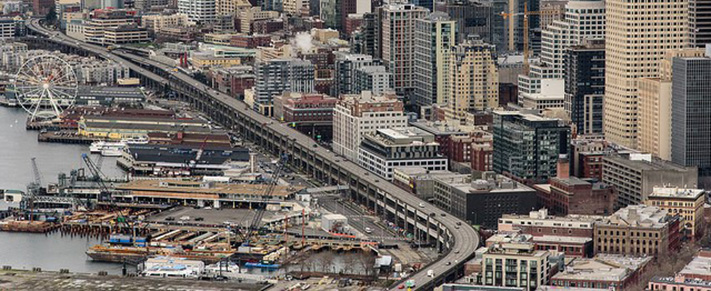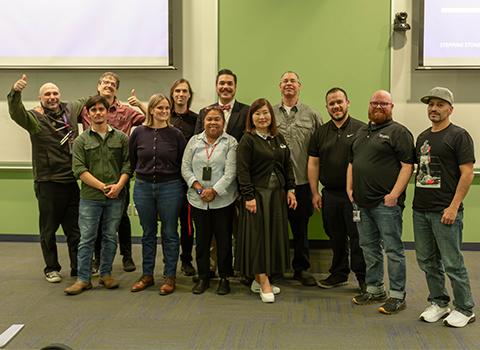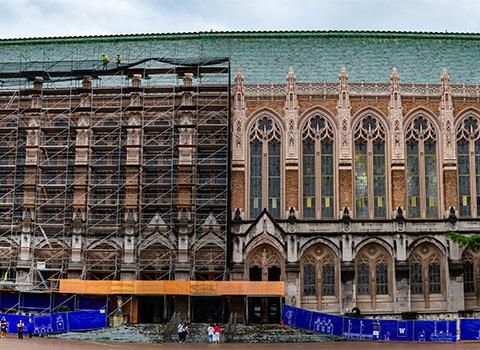Planning for the Viaduct closure

Impacts from the Viaduct closure are expected to be far-reaching
What's going on
What's going on
By now, you have probably heard that the Alaskan Way Viaduct is scheduled to close for three weeks beginning Jan. 11, 2019. You’ve probably also heard the term “Period of Maximum Constraint” floating around. How do these relate and what does that mean for you as a commuter?
The Period of Maximum Constraint is a term coined by Seattle transportation engineers that essentially describes a challenging period of time of increased congestion and traffic in downtown Seattle. Due to added construction projects, including the closure of the Alaskan Way Viaduct, there will be a related increase in traffic and delays in commutes for those traveling through downtown. And much of the Viaduct traffic will likely spill onto I-5, making for some longer freeway commutes.
We understand that construction projects and changes can put a real damper on your commute. Here’s a quick snapshot of information helpful to know in advance of the Viaduct closure that will likely affect anyone traveling through, in or around downtown Seattle.
In order to open the new SR 99 tunnel, Washington State Department of Transportation will close the Alaskan Way Viaduct (SR 99) through downtown Seattle for approximately three weeks. This closure will allow crews to build ramps and roadways to realign the highway into the tunnel. Additional ramp closures before and after the main closure in January will mean that some commuters, especially those headed downtown from the south and west, will face up to six weeks of disruptions.
WSDOT is expecting the closure to impact everyone driving in the immediate Seattle area. Don’t wait until January, start your planning now.
Avoid gridlock and sitting in traffic by considering how you can change your commute patterns. WSDOT has provided some suggestions on how to alter your commute during the closure:
WSDOT tips
WSDOT tips
- Adjust your travel times and know before you go: If your schedule allows, adjust your work hours to avoid peak travel times (usually 6 to 10 a.m. and 3 to 7 p.m.), which may start earlier and end later than typical rush hours during the closure. Check travel times before you travel and stay engaged.
- Ride transit and utilize Park & Rides: Be sure to double check King County Metro and Sound Transit websites for service updates, which may include reroutes for buses that use the viaduct. Resources include OneBusAway and King County Metro Trip Planner. Taking Link light rail could save you a lot of time during your commute. Bus reroutes in the downtown corridor will occur prior, during and after the Viaduct closure. To learn about which buses will be rerouted, where, and when, click here.
- Work from home: Working from home or telecommuting allows you to skip your commute altogether. Talk with your employer about possible options to work from home one or more days during the closure.
- Share the ride – carpool, vanpool, and vanshare: Find someone who is already heading your way by using ride matching services including RideshareOnline.com, Waze, and Scoop.
- Start biking: Haven’t had a chance to commute on two wheels? Well, now is as good a time as ever. Bicycling can be faster than driving or riding transit and removes the stress of sitting in traffic. Nervous about getting started? Explore programs like our Bike Buddy program or information offered by Cascade Bicycle Club.
- Walk: For those able, walking the last part of your trip to avoid the heaviest congestion or walking the entire way if you live within reasonable distance is a free, reliable option that’s good for your, good for the planet, and helps you avoid traffic.
- Water taxi: There are water taxis that carry foot passengers and bicyclists between downtown Seattle and West Seattle or Vashon Island (10 minute and 22 minute trips, respectively). A new ferry, the Kingston Fast Ferry, launched after Thanksgiving weekend to carry passengers from Kingston to downtown Seattle in 39 minutes. Water taxis have easy access and frequent service, making it a great alternative to driving.
UW resources
UW resources
Get personalized assistance: Another great resource to utilize is our free trip planning resource offered by the Commute Options team at UW Transportation Services. This dedicated team will provide UW commuters with personalized trip plans and alternative ways of getting to and from campus.
Adjust your staffing plans: This closure will likely impact your business operations, including staffing plans. UWHR’s Work Disruptions Planning web page provides options that apply to each employment program and any required notification steps. Please contact your organization’s HR consultant if you have questions about time off use, establishing temporary telework arrangements or flexible scheduling, or for assistance in developing your organization’s staffing plan.
Ride UW Shuttles: Did you know that you have access to UW Shuttles, including one that operates on a route between UW Medical Center and South Lake Union via Fred Hutch? And a separate route between South Lake Union and Harborview with stops at Seattle Children’s Research Institute and Benaroya Institute. Hop on a UW shuttle for easy access to South Lake Union and then ride transit or walk into downtown.
Get set up to work remotely by using these IT resources:
Connect to the UW network: Ask your local IT staff to see if your work files are available via the Internet and whether they offer their own VPN services. Alternatives to departmental VPNs include: Husky OnNet for UW campus connections; and UW Medicine Remote Access SSL VPN for access to clinical resources and UW Medicine applications.
Email productivity platforms: Both UW G Suite and UW Office 365 are web-based and accessible from most places via the Internet.
Phones: Access your voicemail from home and use the free Extension Connect feature to extend UW telephone service to a cellular or home telephone number.
Conference calling: Meet with colleagues virtually using Zoom or Skype for Business.
Transportation Services is here to support the UW community and to make commutes to, from and around UW the smoothest they can be. Check back often or visit the UW Transportation Services Facebook page for updates. Transportation Services can also be reached at ucommute@uw.edu and 206-221-3701, Monday through Friday, 9 a.m. to 5 p.m.
SDOT resources
SDOT resources
Check out SDOT’s newly launched website, devoted to helping you coordinate and prepare for Seattle’s new era of tough traffic. This new website contains an explanation of the Period of Maximum Constraint, current traffic times to neighborhoods across Seattle, a Partners page full of resources, and more.



